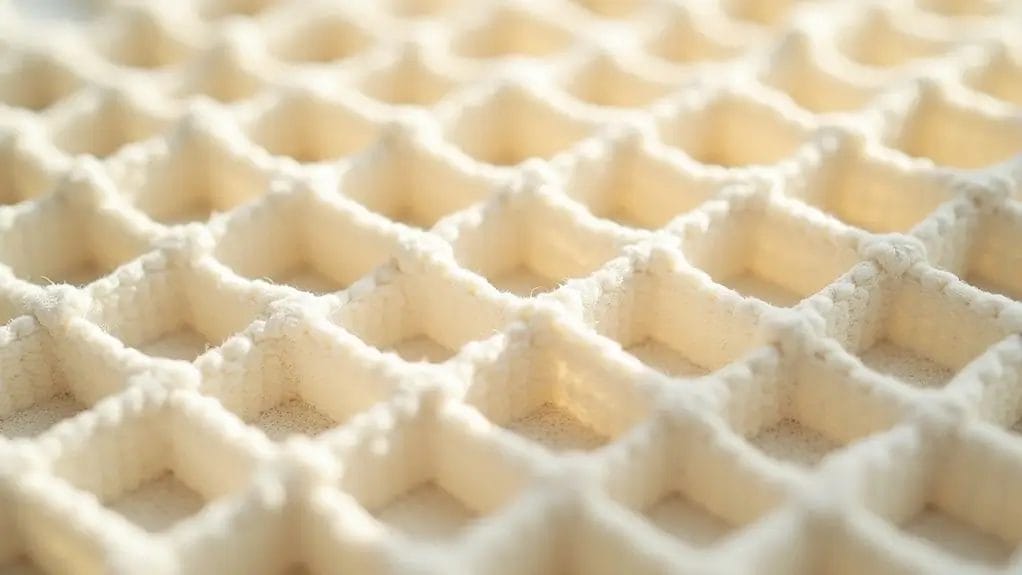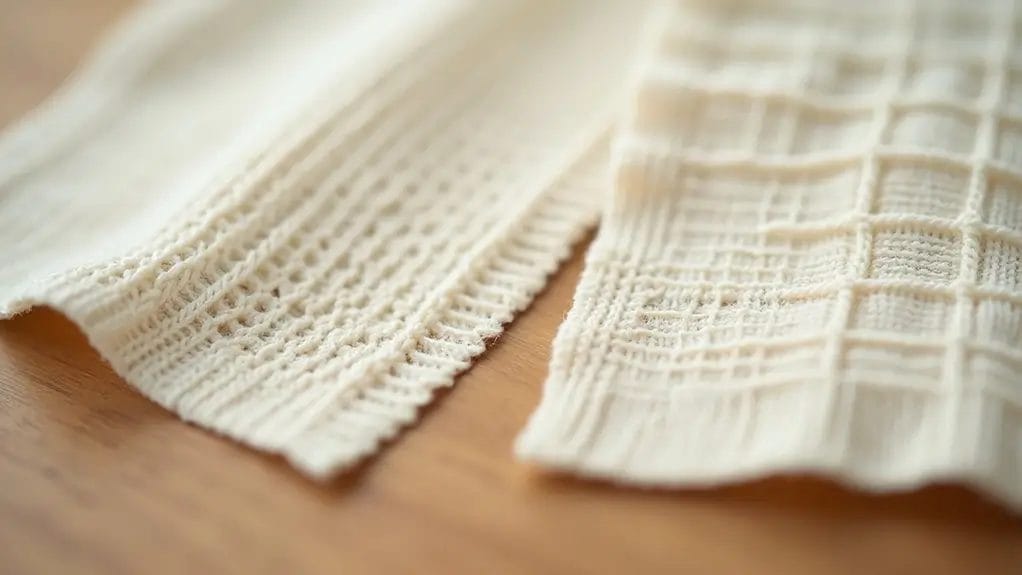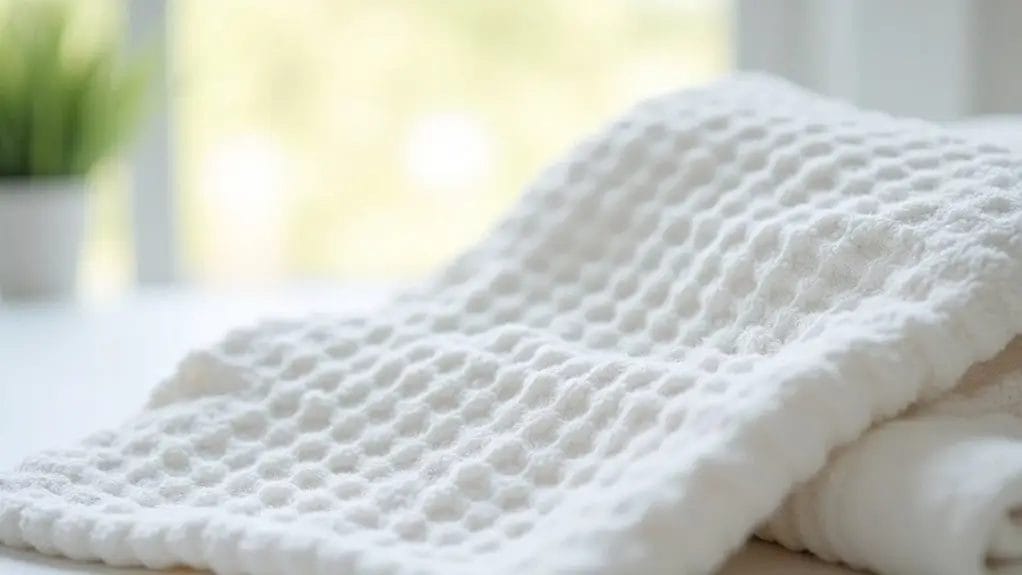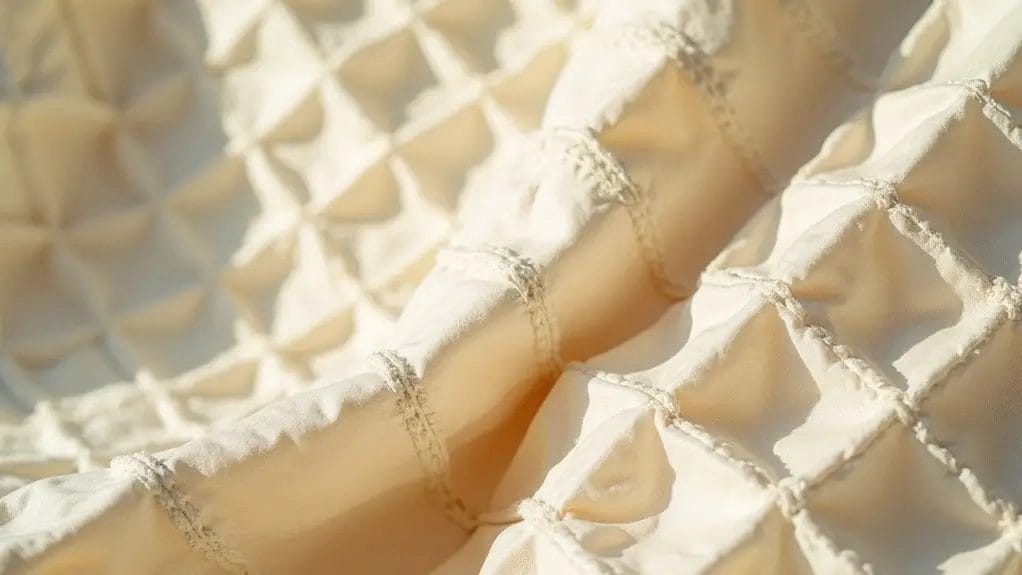You've likely encountered waffle fabric in your everyday life, from the cozy thermal shirt in your closet to the absorbent kitchen towel hanging by your sink. This distinctive textile, characterized by its recessed square or diamond patterns, offers unique structural benefits that set it apart from traditional flat weaves. Whether you're exploring fabric options for clothing projects or seeking to understand your existing waffle-textured items, understanding its composition and capabilities will enhance your textile knowledge.
Key Takeaways
- Waffle fabric features a distinctive honeycomb pattern created through specialized weaving, forming air pockets that enhance breathability and absorbency.
- The fabric's three-dimensional texture provides excellent moisture-wicking capabilities, making it ideal for towels, bathrobes, and thermal clothing.
- Common applications include home textiles, thermal underwear, sweaters, and bedding due to its insulating properties and aesthetic appeal.
- Wash waffle fabric in cool water on gentle cycle, avoid harsh scrubbing, and store flat to maintain its unique texture.
- For stain removal, use gentle enzyme-based cleaners and blot rather than rub to preserve the fabric's honeycomb structure.
What is Waffle Fabric?

Waffle fabric is a three-dimensional textile characterized by its distinctive honeycomb or waffle-like pattern of recessed squares or diamonds.
You'll notice this unique texture is created through a specialized weaving technique that forms raised and lowered areas across the fabric's surface. The structure typically consists of floating yarns that create small pockets of air throughout the material.
When you examine cotton waffle fabric closely, you'll see how the honeycomb fabric construction allows for enhanced absorbency and improved breathability.
These geometric indentations also provide extra surface area and flexibility, making the textile particularly suitable for both clothing and household items.
How Waffle Fabric is Made?

The production of waffle fabric involves a specialized weaving process utilizing a honeycomb or waffle weave pattern on dobby or jacquard looms.
The manufacturing begins with cotton or cotton-blend yarn that's woven or knitted in a raised geometric structure. This unique pattern creates small, regular depressions in the fabric, forming square or diamond-shaped pockets.
The structure's creation relies on the precise tension and arrangement of warp and weft yarns.
During weaving, some yarns float over multiple threads while others are tightly bound, creating the characteristic three-dimensional texture you'll find in waffle fabric.
Key Characteristics of Waffle Fabric

You'll find that waffle fabric's distinct three-dimensional honeycomb pattern creates unique performance characteristics stemming from its raised and recessed surface structure.
The fabric's geometric weave construction influences its texture, weight distribution, moisture management through enhanced surface area, and thermal regulation via trapped air pockets. These structural properties combine to affect the fabric's durability and resistance to pilling, making waffle weave particularly suitable for applications requiring both comfort and longevity.
Texture and Weight
Distinctive honeycomb-like indentations characterize waffle fabric's unique texture, creating a three-dimensional surface pattern that's both functional and visually appealing.
The grid-like structure features raised squares separated by recessed lines, giving the fabric its signature dimensional quality. You'll notice the texture becomes more pronounced after washing, as the yarns contract and enhance the waffle weave fabric's depth.
The weight of waffle fabric varies greatly based on yarn thickness and construction. You'll find lightweight versions ideal for summer clothing and heavyweight options perfect for bathrobes and blankets.
The fabric's structure allows for air pockets that influence its overall thickness and insulating properties.
Absorbency and Breathability
Superior absorbency stands as one of waffle fabric's most notable characteristics, achieved through its three-dimensional construction that maximizes surface area for moisture collection.
You'll find that the raised geometric pattern creates air pockets that enhance both absorbency and breathability.
When made from natural fibers like cotton or bamboo, the waffle weave becomes even more absorbent, efficiently wicking moisture away from your skin.
These air chambers also promote ventilation, allowing air to circulate freely through the fabric's structure.
This combination of moisture management and breathability makes waffle fabric particularly suitable for towels, bathrobes, and performance wear.
Insulation and Thermal Properties
The three-dimensional architecture of waffle fabric creates an exceptional thermal regulation system. The raised squares trap air within their pockets, forming an insulation layer that helps maintain your body temperature.
You'll find that this thermal barrier works efficiently in both cold and warm conditions.
The fabric's unique structure allows it to provide warmth without excessive thickness or weight. The honeycomb pattern creates multiple air chambers that act as lightweight insulators, while the compressed areas between the raised squares allow for proper ventilation.
This balanced combination makes waffle fabric ideal for year-round temperature regulation.
Durability and Pilling Behavior
Beyond its thermal properties, waffle fabric exhibits specific wear characteristics influenced by its textured construction. The durability depends heavily on fiber content, with cotton-polyester blends offering better resistance to wear than pure cotton versions.
You'll notice that the raised squares in the waffle pattern can experience pilling, especially in high-friction areas. Higher-quality fabrics with longer fibers show better resistance to this issue.
Regular washing can affect the fabric's softness and structural integrity, but proper care maintains its dimensional stability. The weave's inherent stretch helps preserve the fabric's shape despite repeated use.
Difference Between Waffle Knit and Waffle Weave

While both create a distinctive honeycomb texture, waffle knit and waffle weave fabrics differ fundamentally in their construction methods and structural properties.
In waffle knit, you'll find the pattern created through specialized knitting machines that form interconnected loops in a geometric arrangement. The fabric's raised squares emerge from alternating knit and purl stitches.
Waffle weave, however, relies on interlacing warp and weft yarns in a specific sequence. The characteristic depressions and elevations result from floating yarns that skip over multiple threads, creating depth through either weaving or knitting techniques that produce dimensionality in the finished textile.
Common Uses for Waffle Fabric

When you examine waffle fabric's commercial applications, you'll find it's extensively used in home textiles, particularly for towels, bathrobes, and thermal blankets where its dimensional texture enhances absorbency and insulation.
In apparel manufacturing, waffle-textured fabrics serve as an essential component in thermal underwear, sweaters, and activewear, where the raised geometric pattern creates air pockets for temperature regulation.
The three-dimensional honeycomb structure makes waffle fabrics especially suitable for both moisture-wicking performance garments and comfort-focused home textiles.
Home Textiles
Waffle fabric serves as a versatile material in numerous home textile applications due to its three-dimensional honeycomb weave structure.
You'll find it commonly used in modern households as a practical alternative to traditional terry towels and textile products.
- Bath essentials: Pre-shrunk waffle weave towels and bathrobes offer superior moisture absorption while maintaining a lighter weight than conventional terry cloth.
- Bedding elements: Blankets and throws featuring waffle texture provide excellent temperature regulation and a sophisticated aesthetic.
- Kitchen accessories: Tea towels and dishcloths made from waffle weave combine quick-drying properties with effective cleaning performance.
Apparel
Beyond its applications in home textiles, the thermal-regulating properties of waffle fabric make it a practical choice for various apparel items.
You'll find waffle knit construction in thermal underwear, loungewear, and pajamas, where its air-trapping pockets provide insulation while maintaining breathability. The stretch characteristics of waffle fabric, particularly in cotton-spandex blends, allow for comfortable movement in activewear and casual clothing.
The dimensional texture of waffle weave adds visual interest to sweaters, hoodies, and layering pieces.
Its moisture-wicking capabilities make it especially suitable for performance clothing and seasonal shift pieces where temperature regulation is essential.
Care and Maintenance Tips for Waffle Fabric

When caring for waffle-textured fabrics, you'll need to follow specific washing protocols that include using cool water temperatures and gentle detergents to maintain the dimensional stability of the honeycomb weave pattern.
To address stains, you should treat spots immediately with appropriate fabric-specific solutions while avoiding harsh scrubbing that could damage the raised geometric structure.
Proper storage requires flat or rolled positioning rather than hanging, which helps prevent the characteristic waffle pockets from stretching or losing their three-dimensional definition.
Washing and Drying Guidelines
To maintain the distinctive honeycomb texture of your waffle weave fabrics, proper laundering techniques are essential.
Whether your garment is pure cotton, polyester, or a blend, following specific care methods will help preserve its unique structure and make it softer with each wash.
- Wash in cold to lukewarm water (30-40°C) using a gentle cycle and mild detergent to protect the raised geometric pattern.
- Turn items inside out before washing to minimize surface wear and prevent snags.
- Air dry flat or tumble dry on low heat, removing promptly to avoid deep wrinkles that can distort the waffle suit.
Stain Removal and Spot Care
Since waffle fabric's raised geometric pattern can trap dirt and debris within its textured surface, proper stain treatment requires swift, targeted action to prevent permanent damage.
For cotton-based waffle fabric, apply a gentle enzyme-based stain remover directly to the affected area and gently blot—never rub. The thicker weave structure demands thorough but careful treatment to avoid distorting the signature pattern.
For high-quality waffle textiles, spot-clean using cool water and mild detergent, working from the stain's outer edge inward.
This versatile fabric responds well to hydrogen peroxide solutions for organic stains, while oil-based marks require specialized fabric cleaners.
Storage and Avoiding Deformation or Shrinkage
Proper storage techniques play a vital role in maintaining waffle fabric's distinctive honeycomb texture and dimensional stability. To prevent unwanted stretch and deformation, follow these essential storage practices:
- Fold your waffle fabric items loosely along natural seam lines, avoiding tight creases that can damage the cotton fibers and distort the honeycomb pattern.
- Store in a cool, dry place with adequate air circulation to prevent moisture buildup that can lead to mildew and fabric deterioration.
- Don't stack heavy items on top of waffle textiles, as the weight can permanently flatten the raised texture and compromise the fabric's natural elasticity.
Frequently Asked Questions
Is Waffle Fabric Suitable for People With Sensitive Skin?
You'll find waffle fabric's raised honeycomb texture gentle on sensitive skin, especially when made from hypoallergenic fibers like organic cotton or bamboo rayon, as it minimizes direct contact with your skin.
How Long Does Waffle Fabric Typically Last With Regular Use?
You'll get 2-5 years from your waffle fabric when properly cared for, though cotton waffles last longer than polyester ones. The honeycomb weave structure maintains durability through regular washing cycles.
Can Waffle Fabric Be Used for Outdoor Furniture or Patio Cushions?
You shouldn't use standard waffle fabric outdoors, as its raised honeycomb structure retains moisture and degrades quickly. Instead, choose specialty outdoor waffle weaves with UV-resistant, waterproof synthetic fibers.
Does Waffle Fabric Get Softer or Rougher Over Time?
You'll notice your waffle fabric becomes softer through repeated washing and use, as the raised honeycomb cells relax and the cotton or linen fibers break down, creating a more supple texture.
What's the Environmental Impact of Waffle Fabric Production?
Your waffle fabric's environmental impact depends on its fiber content. Cotton versions require high water usage, while synthetic waffle weaves generate microplastics. Bamboo alternatives offer a more sustainable production process.
Conclusion
Whether you're choosing waffle knit or weave, you'll find this adaptable fabric offers exceptional moisture-wicking properties and thermal regulation. Its three-dimensional honeycomb structure creates air pockets that enhance insulation and absorbency. By following proper care protocols—cold washing, gentle detergents, and air drying—you'll maintain the fabric's distinctive texture and extend its lifespan. For peak performance, treat your waffle textiles as technical garments requiring specific maintenance.


0 comments